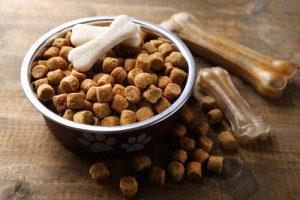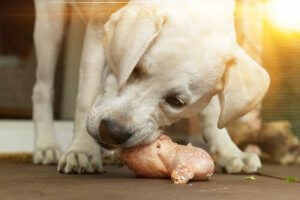Nutrition: 4 Reasons to Avoid Dry Dog Food


Written and verified by the biologist Ana Díaz Maqueda
Over the last century, pet food has changed significantly. Before the Second World War, commercial dry dog food was sold in metal or glass containers.
When the Second War hit, both of these materials were used primarily for making weapons and ammunition. As a result, production of tinned dog food decreased, to be replaced by processed kibble.
These kibbles were terrible quality, made from leftover cuts of meat that weren’t fit for human consumption. Dry food was generally only available in large cities and agricultural areas. In rural areas, owners would simply feed their dogs leftovers from dinner.
This continued until the eighties and nineties, when the number of domestic cats and dogs began to increase significantly. As a result, the pet food industry had to raise its standards to meet the demands and needs of pet owners.
Dry dog food: some are better than others
While we won’t say that dry food is the worst option for your pets, it’s true that some kibbles are worse quality than others.

Good pet food is often pretty expensive. That said, a hefty price tag is no guarantee of quality. In fact, there are a number of well-established brands that produce low-quality foods, but spend thousands of dollars on publicity.
A high concentration of cereals
Dogs are obligate carnivores, meaning meat is their main source of energy. However, as they have evolved and become domesticated, dogs have adapted to tolerate other food types too.
Generally speaking, dry dog food contains high concentrations of wheat, corn and soy proteins. Adding larger amounts of these ingredients helps manufacturers cut costs, but often deceives and confuses consumers.
Consumers often believe that they are feeding their pets a healthy, balanced diet. For example, you may see labels such as, “made with real chicken”. However, on closer inspection, you’ll often find that chicken only makes up a tiny percentage of the ingredients.
A high quantity of cereals can increase the risk of your pet developing conditions such as gastric dilatation.
Processing destroys nutrients
To give them a longer shelf-life, commercial dog food is made using a process called extrusion. During this process, machines compress and dehydrate the kibble using changes in pressure and temperature.
To a greater or lesser extent, this process destroys many of the nutrients in the kibble. Sometimes, manufacturers must include additives to ensure that the animal can absorb the nutrients properly. They may also contain a higher concentration of synthetic trace elements, as most of the natural minerals in the ingredients are lost during the extrusion process.
All this means that dry dog food is ultra-processed. Of course, some kibble is better quality than others, but it can never be compared to a balanced diet of fresh, natural ingredients.
Dental health and dry dog food
In recent years, studies have shown that a diet made up exclusively of dry food can have a negative impact on your dog’s dental health.
Contrary to popular opinion, dry food doesn’t actually help reduce plaque on teeth. In fact, raw bones are the only natural way to eliminate dental plaque in dogs.

According to a number of studies, giving your dog raw dog bones for ten minutes once every two weeks can help to reduce plaque and improve oral health.
Over the last century, pet food has changed significantly. Before the Second World War, commercial dry dog food was sold in metal or glass containers.
When the Second War hit, both of these materials were used primarily for making weapons and ammunition. As a result, production of tinned dog food decreased, to be replaced by processed kibble.
These kibbles were terrible quality, made from leftover cuts of meat that weren’t fit for human consumption. Dry food was generally only available in large cities and agricultural areas. In rural areas, owners would simply feed their dogs leftovers from dinner.
This continued until the eighties and nineties, when the number of domestic cats and dogs began to increase significantly. As a result, the pet food industry had to raise its standards to meet the demands and needs of pet owners.
Dry dog food: some are better than others
While we won’t say that dry food is the worst option for your pets, it’s true that some kibbles are worse quality than others.

Good pet food is often pretty expensive. That said, a hefty price tag is no guarantee of quality. In fact, there are a number of well-established brands that produce low-quality foods, but spend thousands of dollars on publicity.
A high concentration of cereals
Dogs are obligate carnivores, meaning meat is their main source of energy. However, as they have evolved and become domesticated, dogs have adapted to tolerate other food types too.
Generally speaking, dry dog food contains high concentrations of wheat, corn and soy proteins. Adding larger amounts of these ingredients helps manufacturers cut costs, but often deceives and confuses consumers.
Consumers often believe that they are feeding their pets a healthy, balanced diet. For example, you may see labels such as, “made with real chicken”. However, on closer inspection, you’ll often find that chicken only makes up a tiny percentage of the ingredients.
A high quantity of cereals can increase the risk of your pet developing conditions such as gastric dilatation.
Processing destroys nutrients
To give them a longer shelf-life, commercial dog food is made using a process called extrusion. During this process, machines compress and dehydrate the kibble using changes in pressure and temperature.
To a greater or lesser extent, this process destroys many of the nutrients in the kibble. Sometimes, manufacturers must include additives to ensure that the animal can absorb the nutrients properly. They may also contain a higher concentration of synthetic trace elements, as most of the natural minerals in the ingredients are lost during the extrusion process.
All this means that dry dog food is ultra-processed. Of course, some kibble is better quality than others, but it can never be compared to a balanced diet of fresh, natural ingredients.
Dental health and dry dog food
In recent years, studies have shown that a diet made up exclusively of dry food can have a negative impact on your dog’s dental health.
Contrary to popular opinion, dry food doesn’t actually help reduce plaque on teeth. In fact, raw bones are the only natural way to eliminate dental plaque in dogs.

According to a number of studies, giving your dog raw dog bones for ten minutes once every two weeks can help to reduce plaque and improve oral health.
All cited sources were thoroughly reviewed by our team to ensure their quality, reliability, currency, and validity. The bibliography of this article was considered reliable and of academic or scientific accuracy.
- H. de Animales, (2010). Guías para la evaluación nutricional de perros y gatos de la Asociación Americana Hospitalaria de Animales (AAHA). J Am Anim Hosp Assoc, 46(4).
- Gaviria Arango, J. (2016). Alimentación general y especializada para mascotas en una empresa productora de alimentos balanceados para animales (Doctoral dissertation, Corporación Universitaria Lasallista).
- Logan, E. I., Finney, O., & Hefferren, J. J. (2002). Effects of a dental food on plaque accumulation and gingival health in dogs. Journal of veterinary dentistry, 19(1), 15-18.
- Marx, F. R., Machado, G. S., Pezzali, J. G., Marcolla, C. S., Kessler, A. M., Ahlstrøm, Ø., & Trevizan, L. (2016). Raw beef bones as chewing items to reduce dental calculus in Beagle dogs. Australian veterinary journal, 94(1-2), 18-23.
- Raghavan, M., Glickman, N. W., & Glickman, L. T. (2006). The effect of ingredients in dry dog foods on the risk of gastric dilatation-volvulus in dogs. Journal of the American Animal Hospital Association, 42(1), 28-36.
- Tran, Q. D., Hendriks, W. H., & van der Poel, A. F. (2008). Effects of extrusion processing on nutrients in dry pet food. Journal of the Science of Food and Agriculture, 88(9), 1487-1493.
This text is provided for informational purposes only and does not replace consultation with a professional. If in doubt, consult your specialist.








